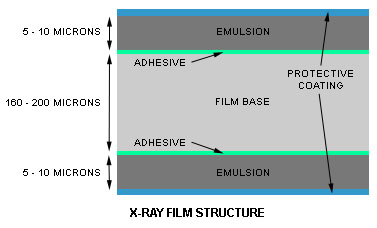 All film is X-ray sensitive so any film can, in theory, be used to record an X-ray image. However, the sensitivity to X-ray radiation of film designed for exposure to the wavelengths of the visible spectrum is much reduced Consequently, very long exposures would be required to achieve a usable image and, in a medical environment, patients would be subjected to unacceptable amounts of X-ray radiation. Conventional radiographic procedures therefore use special film and an intensifying screen which converts the X-ray energy to light so it can be recorded on film relatively quickly. Modern digital techniques are of course leading to further changes of procedure.
All film is X-ray sensitive so any film can, in theory, be used to record an X-ray image. However, the sensitivity to X-ray radiation of film designed for exposure to the wavelengths of the visible spectrum is much reduced Consequently, very long exposures would be required to achieve a usable image and, in a medical environment, patients would be subjected to unacceptable amounts of X-ray radiation. Conventional radiographic procedures therefore use special film and an intensifying screen which converts the X-ray energy to light so it can be recorded on film relatively quickly. Modern digital techniques are of course leading to further changes of procedure.
Daylight films and medical X-ray films are quite different in structure. X-ray film has thicker emulsion, which may be applied to both sides of the film base, and also uses a thicker and stronger film base. The film base, which provides structural strength, must be more or less transparent, dimensionally stable and reasonably flexible to allow for processing. A typical structure for X-ray film is shown in the diagram on the right.
In the case of medical X-ray film, most exposure energy is derived from a fluorescent screen that emits either blue or green light when radiated by X-rays. The films are therefore designed to achieve an extended blue or green spectral sensitivity. A screen system of this type also reduces the exposure of medical subjects to potentially harmful rays. Industrial X-ray films are designed to achieve exposure directly from the X-rays and hence use no screen system. They use phosphors having a spectral sensitivity appropriate for X-rays rather than visible light.






